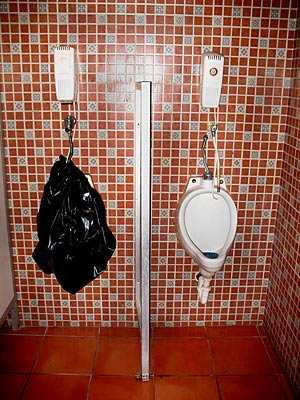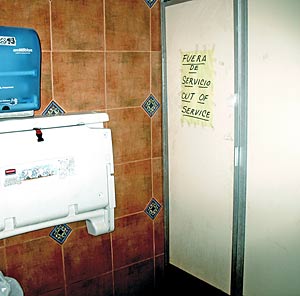It's a truism that a dog will never point
at another dog and sneer at its choice of lavatory.
But then dogs have not erected a barrier between themselves
and Nature (they leave people to do that for them).
If they had, they would be fussy about where they squat
and, like the rest of us, they'd call their barrier
a culture or civilization.
Unlike every other mammal on the planet, we humans
are supremely unequipped to survive without our barrier.
Left in the open to experience Nature's spontaneous
embrace, we would die within days. We would starve or
freeze or boil or become ragged comestibles for the
nearest red-in-tooth-and-claw carnivore.
We need our barrier. We need to be discriminating about
our environment. The fussier we are, the wider the barrier
becomes and the further away we reside from panting
carnivores. Which brings me to bathrooms and how we
need to feed the barrier by paying more consideration
to them.
 The
bathroom is usually the smallest room in a house and
perhaps because of this, receives the least amount of
aesthetic attention. This is a serious oversight. After
all, in terms of keeping our body in a state of balance,
bathrooms deserve to hold our interest more than they
do.
The
bathroom is usually the smallest room in a house and
perhaps because of this, receives the least amount of
aesthetic attention. This is a serious oversight. After
all, in terms of keeping our body in a state of balance,
bathrooms deserve to hold our interest more than they
do.
In exchange for ignoring the adornment-potential of
the bathroom, which we expend on kitchens and living
rooms, we award the smallest room with a large bouquet
of epithets. A kitchen is always just called a kitchen, a
bedroom always a bedroom. But the bathroom wears a multicolor
coat of names such as a restroom, washroom, water-closet,
toilet, head, can, biffy, privy, lavatory, WC, convenience,
powder room, john, dunny, loo, shitter, throne, crapper,
bog, and even the place where you go to give birth to
lawyers. The list is endless. I'm sure most home bathrooms
would gladly trade their entire roster of pet names
for an Hommage vanity or a single Zuccetti waterfall
faucet.
Leaving domestic bathrooms aside, let's focus our attention
on public facilities, in particular, San Felipe's restaurant
restroom.
Restroom is a strange name for it, don't you
think? I can't imagine anyone falling asleep while performing
a principle body function, can you? And there's nothing
very restful about a cubicle crammed with porcelain
appliances, all of which possess amazing skills at magnifying
echoes. The chances of nodding off are as likely as
cat napping next to the tuba at a Wagnerian concert.
The baños of our local restaurants and cafes
have a wide range of aesthetics, if one can use that
word in this context. Some of them are quite picturesque,
in a Picasso-cum-plumber kind of way. Others are completely
incomprehensible and need labels for everything in the
room. Nothing says restroom like stepping into a four-by-four
booth that uses the same five gallon pail for both toilet and sink, offers an in-line ball valve fitting
instead of a faucet, and sports a mirror whose last
address was the windshield of a '62 Chevy pickup.
Perhaps because the inevitability of petty thievery
is taken for granted by the owners of public establishments
in the Baja, encounters with bathroom staples that one
habitually finds in any restroom north of the border
are relatively rare. In many public restrooms here you
are likely to notice the nonattendance of toilet paper,
waste bins, hand towels, soap, urinals, sinks (often
a stand-in for the urinal), water, roof or walls. Of
course, the absence of the restaurant itself often makes
these matters a moot point.
Irony and plastic plumbing are frequently combined
to create an alloy found only south of the border. The
one faucet sink has not yet been invented but is something
that would help downsize the decision-making process
for the hygienic few who are constantly duped by the
presence of a hot water tap. These taps are never connected
to anything. Untwisting their chrome crowns only adds
insult to the affront of calling the place a 'washroom',
especially on a cold morning. The cold water tap (on
the other hand) is a different story. The water will
either drip out at Chinese torture intervals or hose
the entire room down in one efficient blast. And when
you reach for paper towels, there is an empty space
on the wall with no forwarding address. Right above
the space is a plastic sign that reads in Spanish (translated):
| |
You are required
by law to wash your hands
before leaving this room and resuming work. |
 The
establishment has cleverly saved a few dollars by noting
you are not required by law to dry your hands. One can
only assume the owner does not eat at his own diner,
given the unlikelihood the employees bother to wash
their hands when they are not provided a means to dry
them. And the cook is left to wonder why the bread has
a problem rising.
The
establishment has cleverly saved a few dollars by noting
you are not required by law to dry your hands. One can
only assume the owner does not eat at his own diner,
given the unlikelihood the employees bother to wash
their hands when they are not provided a means to dry
them. And the cook is left to wonder why the bread has
a problem rising.
Hygiene has a long history which, like most of mankind’s accrued patterns of behavior, finds its nursery in the behavior of other animals. Cats, squirrels, and rabbits use their forepaws and saliva to bathe themselves. Snakes, frogs and lizards shed their outer skin. Monkeys and lemurs have their fur groomed by close friends and relatives. Some chimpanzees wash their face with cold water every day. Bats, moles and hedge hogs comb themselves with their nails. Bears, elephants, hogs, and many types of birds make ample use of water to clean themselves, when the opportunity arises.
When man is unable to take his cue from Nature, he is content to follow the precepts of the local holy book. Here is what the Old Testament advises:
“And thou shalt have a paddle upon thy weapon; and it shall be, when thou wilt ease thyself abroad, thou shalt dig therewith, and shalt turn back and cover that which cometh from thee.” (Deuteronomy 23:13-14) Of course, this may just have been a transcribed observation of the hygienic behavior of cats. Cats were sacred in ancient Egypt and according to some scholars, the Old Testament is a record of specific Egyptian dynasties.
My first experience at a south-of-the-border baño
was forty years ago in San Luis. I had transported my
rumbling stomach to a bus depot in a search of a restroom.
The only candidates appeared to be two open doorways,
one labeled Dames, the other Caballeros.
The first was easy enough to translate and by a shrewd
process of elimination, so was the second (although
I was intimidated by the thought of performing intimate
body functions while on horseback).
When I stepped through the appropriate opening, I was
alarmed to discover there was no toilet paper residing
in any of the cubicles. I searched my pockets for any
papers softened by age or copious deposits of lint then
retreated, suspecting I had been thwarted by bad timing.
Yet I had not seen any discarded cardboard cylinders
anywhere in the bathroom. I decided to stand back and
watch the door, expecting to see patrons ferrying their
own hygienic essentials into the banos. Instead I witnessed
a woman stop at the door entrance, reach over to a roll
of toilet paper hanging on the wall between the two
bathroom doors, unreel a length, tear it off and disappear
inside.
I was astonished. Even though I had walked past the
roll, was only inches from it, I never saw it. It must
be a cultural thing, but I apparently have a blind spot
where a roll of toilet paper can hang from a wall in
the lobby of a bus depot.
A few days later I was at a bar in Puerto Penasco.
It was New Year's Eve. I had imbibed several beers and
was once again in a position to avail myself of a public
utility. After a semaphore exchange with the bar tender
(the universal language), I found myself in a dark cinder
block cave that reeked of urine and a sundry other human
mulch products. It was immediately obvious this place
was rudimentary, to the point of being of interest to
Amnesty International. The bank of expected urinals
was homogenized into a single trench etched into the
concrete floor. The gutter slanted across the room and
exited through a scupper in the opposite wall. Beside
the entrance, a bank of stained tiles rose up from the
canal, as a kind of target range for the drunks. The
place had the aesthetics of a Turkish prison.
The broadening of the barrier that separates us from
Nature is intimately related to the flow of money in
any culture. San Felipe enjoyed a period of prosperity
when a flock of realtors descended on it during the
last decade. The vein of aesthetics doesn't carry much
blood when its source derives from the real estate industry
(unless you consider metal coyotes and cement fountains
artistic triumphs). Yet somehow a small dribble of lucre
found its way into the collective restrooms of San Felipe.
True, almost none of it went into aesthetics, but at
least these days when you turn a faucet, water will
flow into porcelain catchments and after you push a
toilet handle, the contents will be expelled in the
correct direction.
The barrier south of the border is gaunt, compared
to its counterpart north of the border. Aesthetics takes
a back seat to perceived necessities (it appears the
two come together in the iphone). Transportation and
entertainment are high on the list of local priorities.
Bathroom furniture is a distant prerogative.
In countries where the barrier is thin, hygiene is
an abstract word, as meaningless as terms like 'million'
or 'frost-free' or "high-definition". What
isn't visible to the eye is unimportant. Visual opiates
like satellite TVs and cell phones with texting abilities
help keep the attention way from trenches that flow
through scuppers in walls. Besides, after the entertainment
bills are paid, there's no money left for plumbing anyway.
So until the culture widens to embrace the potential
aesthetics of the domestic bathroom, with all its hygienic
permutations, be aware that when you stand and turn
toward the restaurant biffy, you are not in a land that
enjoys a comfortable barrier. When you push that handle,
you are metaphorically in Vegas. You take your chances.